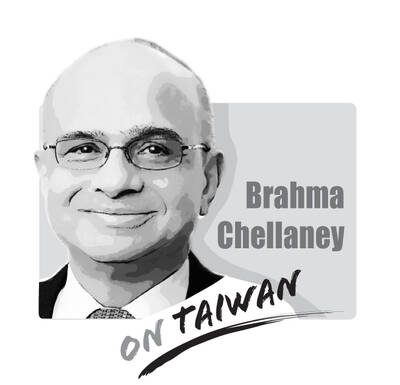A message appeared on an overseas dissident Web site on Feb. 19, calling on people to gather at 2pm the next day in 13 major Chinese cities, including Beijing, Shanghai, Tianjin and Nanjing. The message was quickly spread on Twitter and Facebook, and pretty soon everyone was talking about the “Jasmine Revolution.”
Sure enough, on Sunday afternoon, people went to the suggested locations. The Jasmine Revolution had begun in China, albeit on nothing like the scale we have seen in the Middle East in recent weeks.
What I find more interesting than the response of the people is that of the authorities. A lot of people who read the original posting were doubtful it would actually come off. The majority found it difficult to believe that a large scale demonstration could ever take place in China.
However, the authorities did take it seriously. A message was sent out on Feb 19, with universities warning students to avoid participating in any marches.
On the day itself, the military police and riot police were out in force and online traffic on Wu Mao [(五毛), a pro-Chinese Communist Party (CCP) online commentator], Twitter and Facebook pages increased. The irony of there being more police on the streets than demonstrators, was not lost on our fellow netizens.
There was something endearingly postmodern, they wryly remarked, about a democratic revolution announced by the online community, enthusiastically taken up by communist autocrats, and attended en masse by the security forces.
This online-inspired “jasmine” event relayed a number of messages.
First, the social revolutions happening in the Middle East have begun to influence events in China.
Second, the authorities in China are clearly worried about how stable society is right now. The fact that the Internet is controlled means not many people in China were really aware of the online call-to-arms, but the authorities were not taking any chances, regardless.
In principle at least, the authorities should have access to more information on what is going on in China than individuals in other countries, and so should be more informed about just how stable Chinese society really is.
Consequently, their reaction sends a clear message to the outside world. Namely, that Chinese society has already entered a period of significant instability.
The third signal is that this event was based on the same model as that which set off the revolution in Egypt.
It all started online, and emerged among online chatter, without anyone conspicuously orchestrating events. This model, then, is the third reference point, -demonstrating that henceforth Chinese civil society has a number of ways of making itself heard.
It is true that the experiment was not exactly a resounding success, but that is not to take away from the fact that the objective was achieved.
More importantly, if the momentum is kept up and the experiment repeated, people will gradually come to realize the kind of strength they have, keeping the government always wary.
The past few days have also shown us that in today’s China, the stand-off between the state and civil society has entered a new phase, and the Internet is gradually creating the right environment for a revolution by the people.
Observers who hold out little hope of a democratic movement emerging in China should perhaps take another look at what’s going on in the country. From these seemingly insignificant beginnings springs much hope.
Wang Dan is a visiting assistant professor in the College of Humanities and Social Sciences at National Tsing Hua University.
TRANSLATED BY PAUL COOPER

Taiwan stands at the epicenter of a seismic shift that will determine the Indo-Pacific’s future security architecture. Whether deterrence prevails or collapses will reverberate far beyond the Taiwan Strait, fundamentally reshaping global power dynamics. The stakes could not be higher. Today, Taipei confronts an unprecedented convergence of threats from an increasingly muscular China that has intensified its multidimensional pressure campaign. Beijing’s strategy is comprehensive: military intimidation, diplomatic isolation, economic coercion, and sophisticated influence operations designed to fracture Taiwan’s democratic society from within. This challenge is magnified by Taiwan’s internal political divisions, which extend to fundamental questions about the island’s identity and future
The narrative surrounding Indian Prime Minister Narendra Modi’s attendance at last week’s Shanghai Cooperation Organization (SCO) summit — where he held hands with Russian President Vladimir Putin and chatted amiably with Chinese President Xi Jinping (習近平) — was widely framed as a signal of Modi distancing himself from the US and edging closer to regional autocrats. It was depicted as Modi reacting to the levying of high US tariffs, burying the hatchet over border disputes with China, and heralding less engagement with the Quadrilateral Security dialogue (Quad) composed of the US, India, Japan and Australia. With Modi in China for the
The Chinese Nationalist Party (KMT) has postponed its chairperson candidate registration for two weeks, and so far, nine people have announced their intention to run for chairperson, the most on record, with more expected to announce their campaign in the final days. On the evening of Aug. 23, shortly after seven KMT lawmakers survived recall votes, KMT Chairman Eric Chu (朱立倫) announced he would step down and urged Taichung Mayor Lu Shiow-yen (盧秀燕) to step in and lead the party back to power. Lu immediately ruled herself out the following day, leaving the subject in question. In the days that followed, several
The Jamestown Foundation last week published an article exposing Beijing’s oil rigs and other potential dual-use platforms in waters near Pratas Island (Dongsha Island, 東沙島). China’s activities there resembled what they did in the East China Sea, inside the exclusive economic zones of Japan and South Korea, as well as with other South China Sea claimants. However, the most surprising element of the report was that the authors’ government contacts and Jamestown’s own evinced little awareness of China’s activities. That Beijing’s testing of Taiwanese (and its allies) situational awareness seemingly went unnoticed strongly suggests the need for more intelligence. Taiwan’s naval